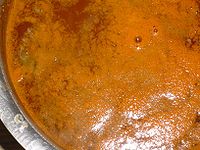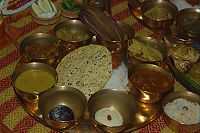- Rasam
-
Rasam 
Origin Alternative name(s) Saaru (Karnataka)
Chaaru (Andhra Pradesh)Place of origin South India Dish details Main ingredient(s) Lentils, tomatoes, water Rasam (Tamil: ரசம், Malayalam: രസം, Kannada: Saaru, ಸಾರು) is a South Indian soup.[1] Traditional preparation involves tamarind juice as base in addition to tomato, chili pepper and other spices as seasonings. Steamed lentils are added by some along with any preferred vegetables.[2] Nowadays all the seasonings required are combined and ground beforehand into a Rasam Powder which is then readily used. These powders or paste are also available commercially.
It is eaten with rice or separately as soup. In a traditional meal, it is preceded by a sambar rice course and is followed by curd rice. Rasam has a distinct taste in comparison to the sambar due to its own seasoning ingredients and is usually fluid in consistency.
Contents
History
In Sanskrit language, 'Rasa' means Juice[3]. It can refer to any juice but in Tamil simply rasam commonly referred to the one prepared with Tamarind/Tomato juice with added spices. Saaru (ಸಾರು) in Kannada language or Chaaru (చారు), in Telugu language, means "essence," and, by extension, "juice" or "soup".[4] Historically, it was prepared mainly with black pepper and tamarind, both ingredients native to and abundant in South India in general. It is also referred to as SatruAmudhu (Tamil: சாற்றமுது) by Iyengars.
Sourashtras, an immigrant community living in Madurai from the 16th century, still refer to it as Pulichaar (Puli or Pulipu means tart (tamarind). Rasam is the basis of the Anglo-Indian Mulligatawny soup.
Types
There are different kinds of rasam, varying by ingredient:
- Tomato rasam,[5] Lemon Rasam, Meriyala/Milagu (Pepper) rasam, Neem flower rasam, Ginger rasam, Garlic Rasam, Pineapple Rasam,[6] Parupu (Dal) rasam, etc.
Regional varieties
- Bassaaru - derives its name from "basida saaru" (Kannada), which is the act of draining water from boiled vegetables/greens/lentils.
- Milagu Saaru - known in the West the Mulligatawny soup (milagu = pepper, tanneer = water).
- Tomato Saaru - with tomato puree as main ingredient.
- Tamarind Saaru - with tamarind extract as main ingredient and without lentils.
- Hesaru Kaalu Saaru - Green gram soup.
- Pappu Saaru - common variant made with pulses and tomato stock.
- Baellae Saaru - most common variety with toor dal, coconut and tamarind juice.
- Majjiga Saaru - soup made with seasoned buttermilk.
- Ulava Saaru - Horse gram soup.
- Kattu saaru - kattu refers to the water drained from the cooked dal.
- Kandathippili rasam
- Kattina saaru - a semi-sweet rasam using jaggery.
- Jeerige saaru - made with jeera, cumin.
- Lemon rasam - a sour soup made with lemon juice.
- HuraLi saaru - a healthy rasam made with horse-gram.
- Mysore Rasam - a fragrant soup made with fried grams/dals.
- Kundapura koli saaru - made with chicken.
- Kottambari jeerige Saaru - made with coriander and cumin seeds.
- Kadale Saaru - soaked black chickpeas, coconut and ginger.
- Alasundae Saaru - black eyed peas and potato, coconut and ginger.
- Vankaaya Saaru - eggplant and tamarind juice.
Saaru in Karnataka
Saaru (ಸಾರು) in Karnataka is different from rasam in Tamil Nadu, and chaaru in Andhra Pradesh. It has more protein, a thicker consistency, and more varied ingredients. Typically, lentils are set to boil along with a teaspoon of oil. Lentils are cooked with a curry powder known in Karnataka as Saarina Pudi (saaru powder), along with salt, sugar, lemon juice, curry leaves, fried mustard seeds and a pinch of asafoetida powder. The curry leaves are added towards the end. Optionally, chopped coriander leaves and grated coconut are also added.
Kattu saaru, part of Udupi cuisine, does not use saaru powder or tomato. Instead, thogari bele (lentil), ginger, lime juice, hingu (asafoetida), curry leaves and coriander leaves are used. Kattu saaru is seasoned with mustard seeds and red chilli (Byadgi variety). Teli saaru, also of Udupi cuisine, is made by sieving water from plain rice cooked in an open pot. This water, which has a thick consistency, is known as teli and is sautéed with mustard, salt, asfoetida and chilli preferably in ghee (clarified butter). The Teli saaru is generally eaten with cooked plain or parboiled rice.
See also
References
- ^ http://www.independent.co.uk/life-style/food-and-drink/recipes/rasam-525477.html
- ^ http://www.hindu.com/mp/2007/05/21/stories/2007052150340800.htm
- ^ Arthur Anthony Macdonell, A Practical Sanskrit Dictionary [1]
- ^ http://www.expressindia.com/latest-news/Sharing-joys-and-worries-in-city/250634/
- ^ "Recipe for tomato rasam"
- ^ "Recipe for pineapple rasam"
External links
Categories:- Soups
- Indian cuisine
- Tamil cuisine
- Kerala cuisine
- Andhra cuisine
- Coconuts
- Karnataka cuisine
- Curry
- South Indian cuisine
Wikimedia Foundation. 2010.

